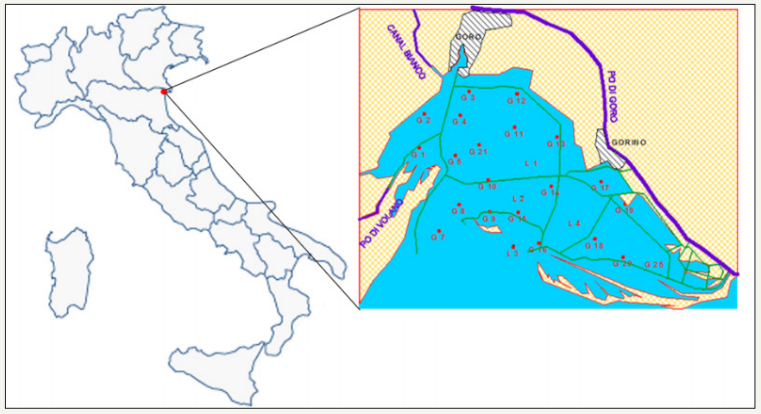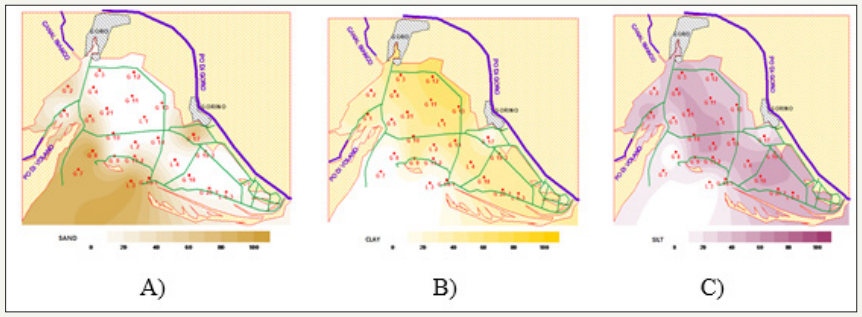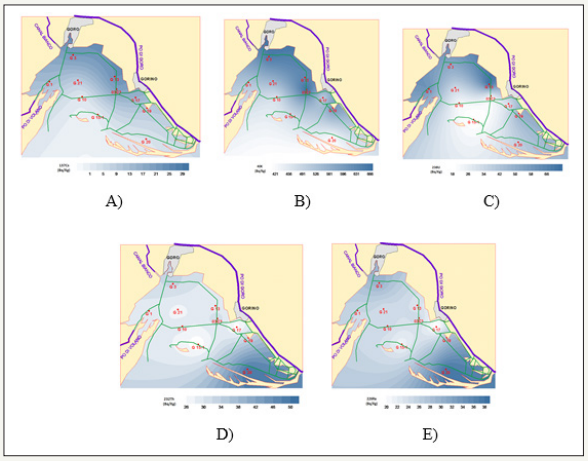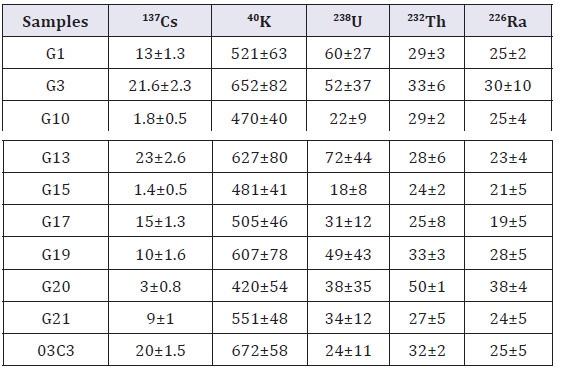- Submissions

Full Text
Environmental Analysis & Ecology Studies
Evaluation of The Radionuclide Concentration in The Sediments of The Sacca Di Goro (Italy)
Chiara Telloli1*, Antonietta Rizzo1, Linda Bertelli2, Paolo Bartolomei1, Elena Marrocchino3 and Carmela Vaccaro2
1Italian National Agency for New Technologies, Energy and Sustainable Economic Development (ENEA), Fusion and Technology for Nuclear Safety and Security Department (FSN), Nuclear Safety, Security and Sustainability Division (SICNUC), Methods and Techniques for Nuclear Safety, Monitoring and Traceability Laboratory (TNMT), Italy
2Department of Physic and Earth Science, University of Ferrara, Italy
3Elena Marrocchino is from Department of Physic and Earth Science, University of Ferrara, Italy
*Corresponding author: Chiara Telloli, ENEA, Bologna Research Center, Fusion and Technology for Nuclear Safety and Security Department, Nuclear Safety Security and Sustainability Division, via Martiri di Monte Sole 4, 40129, Bologna, Italy
Submission: December 21, 2018; Published: January 18, 2019

ISSN 2578-0336 Volume4 Issue5
Abstract
Chernobyl accident introduced many radionuclides into the environment and Sacca di Goro, in the Adriatic Sea (north of Italy) is one of the areas affected by the contamination of Chernobyl products. Since the average lifetime of many radionuclides emitted by the fall-out is now over, a further campaign was carry out to check the current situation of these radionuclides. Sediment samples were collected in the lagoon of Sacca di Goro (Ferrara, Italy). The radionuclide concentration was analyzed by High Purity Germanium Radiation Detectors. The results allow to create a complete mapping describing the spatial distribution of 137Cs, 40K, 238U, 232Th and 226Ra in the sediment of Sacca di Goro after Chernobyl radionuclide contamination.
keywords137Cs 40K 238U 232Th 226Ra; Sediment; Sacca di goro; Lagoon
Introduction
The radioisotopes characterization is important for the estimation of health risk from exposure to a particular radioactive element. This focus has become a primary importance after Chernobyl accident (April 1986) in which it was calculated that at least 60-80% of the core leaving from the protection screen emitting radioactive material into the atmosphere as dust, gases and aerosols, especially 137Cs equivalent to 14x1018Bq IAEA [1] The Po delta region (Emilia-Romagna, Italy) is one of the areas affected by the contamination of Chernobyl products [2]. For this reason, different studies were carried out to evaluate the presence of radioactive elements after Chernobyl event [2-5] and in the specific site of the Sacca di Goro [6,7]. In this revision, analysis of the radionuclides in the Sacca di Goro produced by the Chernobyl accident and of other radioactive elements that can contribute to genetic mutation has been repeated. Sacca di Goro is a typical habitat of many fish, in particular clams and mussels [8,9]. Mussel farming, including Manila clam, Tapes philippinarum, has made Goro the Italian reference area for mollusk production [9-11]. It is important to note that mollusks are bioaccumulator of radioactive elements and therefore they may transfer the radioactivity into higher organism [12,13].
Parisi et al. [6,7] verified that the radioactivity levels of 134Cs, 137Cs, 103Ru and 106Ru were particularly high in some algal in the Goro lagoon: the concentration of radioisotopes was up to 10 times higher than those of the sediments in which they were found. Recently, the annual reports of the Regional Agency for Prevention, Environment and Energy of Emilia-Romagna ARPAE Emilia- Romagna [8] proved that mollusks and sea fish show in some cases the presence of 137Cs with values close to the limit of detection. This revision aimed to characterize the actual concentration of some radioisotope in the Sacca di Goro, radionuclide accumulation environment probably tied to the erosion sediment transport.
Gamma-ray spectroscopy provides an inexpensive and efficient method for measuring the contamination of the environments. In general, radionuclide concentrations in environmental samples may be determined by means of radiochemical separations, followed by alpha- and beta-ray spectroscopy. But these techniques, in comparison with high-resolution gamma-ray spectroscopy, are laborious and time consuming, preventing an extensive sampling procedure often demanded by environmental programs. In recent years, the application of on-line minicomputers to the analysis of complex gamma-ray spectra has further facilitated and tailored the process of data reduction, error analysis, and search for radionuclides decay series. Following this study, soil samples were collected on Sacca di Goro and analyzed by High Purity Germanium Radiation Detectors to characterize the concentration and the spatial distribution of 137Cs, 40K, 238U, 232Th and 226Ra.
Materials and Methods
Field site
Sacca di Goro is one of the largest saltwater lagoon of the Adriatic Sea with a surface area of about 26 hectares and located in the southern part of the Po river delta (44.78-44.83 N and 12.25- 12.33 S) in Ferrara province (Italy). A sandbar of about 1500m between the Volano seashore and the estuary of the Po of Goro puts the lagoon in communication with the open sea. The depth varies from 60-70cm to 2m in relation to river (Po di Goro, Po di Volano and Giralda Valley) and seawater inflows [14,15]. The mixture of freshwater and saltwater determines a salinity level of about 23%. The sea sediments are characterized by loam and silt and by sandy bottoms where the Sacca empties into the sea [12]. The Sacca di Goro is an important area for its ecological peculiarities of the environment that permit the existence of animal and vegetable communities. For this reason (Figure 1), from 1981 it is recognized among wetlands of international importance for aquatic avifauna as defined by the Ramsar Convention [16].
Figure 1:Map of the sampling site. In detail the sampling point for the radionuclide characterization in the Sacca di Goro, Ferrara (Italy).

Sampling and analytical techniques
Samples were collected in the same point of which collected by Parisi et al. [6,7] in order to compare 137Cs concentration after Chernobyl event. The sediments were collected to a depth of 5cm. After collection, samples have been placed in polyethilene bags to be transported to the laboratory of the Italian National Agency for New Technologies, Energy and Sustainable Economic Development (ENEA) Research Center in Bologna (Italy).
For each sample, 100g of sediment was dried in an oven to remove moisture. The isotopic analysis of 137Cs, 40K, 238U, 232Th and 226Ra was carried out using two High Purity Germanium Radiation Detectors, (HPGe, ORTEC, Ametek, Tennessee, USA) with a relative efficiency of 20 and 10% respectively and powered by a voltage of +4000V and -2500V. The gamma spectra were displayed by Gamma Vision software (Ortec, Tennessee, USA). The analysis of the gamma spectrum identifies the radionuclides in the sample and quantifies the activity as the average number of radioactive decays per second (Bq) and per unit of mass (Bq/Kg).
Result
Shows the grain size distribution of the sediments in the sampling area, which identify three different pattern: silt and clay near the coast and sands to the open sea (Figure 2). 137Cs, 40K and 238U spatial distribution in the sediments of Sacca di Goro, which is similar to each other. The major concentrations are located in the north of the lagoon near the coastal line as shown in Table 1. In this area the percentage of clay is higher due to the negligible effect of the wavy wave. These distributions are different with respect those of 232Th and 226Ra, which constant distributions. These figures display an accumulation located in the south-east part of the lagoon, which is composed by sand sediments (Figure 3).
Figure 2:Grain size distribution of sediments in the sampling area of the Sacca di Goro, Ferrara (Italy): A) Silt, B) Clay, C) Sand.

Figure 3: Spatial distribution of the radionuclide analyzed in the sediments of the Sacca di Goro: A) 137Cs; B) 40K; C) 238U; D) 232Th; E) 226Ra.

Table 1:Concentration of each radionuclide in the different sampling site in the Sacca di Goro, expressed in Bq/ Kg.

Discussion
Parisi et al. [5,6] showed the spatial distribution of 106Ru, 134Cs, 137Cs, 40K, 238U and 232Th analyzed in the sediments of the Sacca di Goro after the Chernobyl accident. The results showed that the Sacca di Goro is an accumulation environment of artificial radionuclides from the fall-out. It is assumed, in fact, that the accumulation is attributable to flocculation processes: mixture of fresh and saltwater. In particular, this take place with low-density sediments, that is with a high content of silt and clay. The spatial distribution, especially for 137Cs, 40K and 238U, confirms the results illustrate in Parisi et al. [6,7]. This accumulation may be due to the adsorption by clay minerals and organic material, that characterize the sediments of the lagoon.
The different spatial distribution of 232Th and 226Ra compared to the other radionuclides is probably due to different environmental conditions inside the Sacca di Goro. In the south-eastern part of the lagoon the reductive oxide conditions may facilitate the deposition of thorium ions into the sediments. Frignani et al. [17] analyzed the activity of 137Cs in the sediments near the Po Delta areas, in order to determine the processes that influence the distribution of radionuclides in the marine environment. The highest values have been found in the area characterize by the deposition of silts and clays. On the contrary, the minimum levels characterize sands located in the open sea.
The annual reports of ARPAE [18,19] showed that the superficial sediments of the Sacca di Goro behave as described for the sediments of the Upper Adriatic Frignani et al. [17], confirming the decreasing trend of 137Cs concentrations moving away from the Po Delta.
These results confirm that the distribution of 137Cs is influenced by the deposition or not of fine-grained sediments on the seafloor. Cs tends to concentrate in the clayey sediments. Dynamic areas are correlate with poor sedimentation and consequently do not show significant contamination of Cs from the Chernobyl accident [17]. Parisi et al. [6,7] showed a 137Cs average concentration of 40Bq/Kg, with an increase from 3 to 9 times depending on the area. In addition to this, the isotopic ratio of 137Cs/134Cs identifies the northern area of the lagoon as the most polluted Parisi et al. [6,7]. ARPAE [18,19] illustrated value of 137Cs concentration between 4.6 and 14.1Bq/Kg, confirming the influence of the sediments coming from the Po river.
Conclusion
Although many years have passed since the Chernobyl accident, 137Cs are still observed in the investigated area. The results of the analyzes show that the largest accumulations are located near the coast, characterized by fine-grained sediments. Fortunately, the studied area is not affected by mollusk cultures, so it would be necessary to investigate possible bioaccumulation in the clams and mussels’ habitat. In the next works, preliminary analyzes are planned on the sediments and then subsequent analyzes on plants.
References
- IAEA (2006) Environmental consequences of the Chernobyl accident and their remediation: twenty years of experience. Report of the UN Chernobyl Forum Expert Group “Environment” (EGE). International Atomic Energy Agency, Vienna, Austria.
- Bondavalli C (2003) Effect of eutrophication upon radionuclide dynamics in the Sacca di Goro lagoon (Po River Delta, Italy): a combined field, experimental and modeling study. Environ Pollut 125(3): 433-446.
- Baverstock K, Williams D (2006) The chernobyl accident 20 years on: an assessment of the health consequences and the international response. Environ Health Perspect 114(9): 1312-1317.
- Rojavin Y, Seamon MJ, Tripathi RS, Papadimos TJ, Galwankar S, et al. (2011) Civilian nuclear incidents: An overview of historical, medical, and scientific aspects. J Emerg Trauma Shock 4(2): 260-272.
- Alkhomashi N, Monged MHE (2015) Long-term assessment of contaminated articles from the Chernobyl reactor. J Environ Radioact 144: 52-56.
- Parisi V, Mezzadri MG, Occhipinti A, Poletti G (1991) The contribution of the marine species of macrobenthos and radiocontamination to the understanding of the functioning of the Sacca di Goro. In: Integrated study on the ecology of the Sacca di Goro. Franco Angeli Publishing House, Italy, pp. 205-252.
- Parisi V, Mezzadri MG, Poletti G, Cattani S (1994) Research on the animal macrobenthic population and on the radiocontamination of the Sacca di Goro. In: Integrated study on the ecology of the Sacca di Goro- 2nd Year of research. Franco Angeli Publishing House, Italy, pp. 245-268.
- ARPAE Emilia Romagna (2018) Control network of environmental radioactivity in the Emilia-Romagna Region. Environmental Radioactivity Excellence, Provincial Section of Piacenza.
- Viaroli P, Marinov D, Bodini A, Giordani G, Galbiati L, et al. (2007) Analysis of clam farming scenarios in the Sacca di Goro lagoon. Transitional Waters Monographs 1: 71-92.
- Ludovisi A, Castaldelli G, Fano EA (2013) Multi-scale spatio-temporal patchiness of macrozoobenthos in the Sacca di Goro lagoon (Po River Delta, Italy). Transitional Waters Bulletin 7(2): 233-244.
- Vincenzi S, Caramori G, Rossi R, De GA (2006) Estimating clam yield potential in the Sacca di Goro lagoon (Italy) by using a two-part conditional model. Aquaculture 261(4): 1281-1291.
- Carafa R, Wollgast J, Canuti E, Ligthart J, Dueri S, et al. (2007) Seasonal variations of selected herbicides and related metabolites in water, sediment, seaweed and clams in the Sacca di Goro coastal lagoon (Northern Adriatic). Chemosphere 69(10): 1625-1637.
- Binelli A, Cogni D, Parolini M, Provini A (2010) Multi biomarker approach to investigate the state of contamination of the R. Lambro/R. Po confluence (Italy) by zebra mussel (Dreissena polymorpha). Chemosphere 79(5): 518-528.
- Sacchi A, Mouneyrac C, Bolognesi C, Sciutto A, Roggieri P, et al. (2013) Biomonitoring study of an estuarian coastal ecosystem, the Sacca di Goro lagoon, using Ruditapes philippinarium (Mollusca: Bivalvia). Environ Pollut 177: 82-89.
- Casatta N, Mascolo G, Roscioli C, Viganò L (2015) Tracing endocrine disrupting chemicals in a coastal lagoon (Sacca di Goro, Italy): Sediment contamination and bioaccumulation in Manila clams. Sci Total Environ 511: 214-222.
- Pagnoni GA, Caramori G (1999) Goro and its territory, a guide between history and nature. Ferrara, Italy, p. 32.
- Frignani M, Sorgente D, Langone L, Albertazzi S, Ravaioli M (2004) Behavior of Chernobyl radiocesium in sediments of the Adriatic Sea off the Po River delta and the Emilia-Romagna coast. J Environ Radioact 71(3): 299-312.
- (2003) Environmental radioactivity in Emilia-Romagna. Environmental Radioactivity Excellence, Provincial Section of Piacenza, Piacenza, Italy.
- ARPAV (2002) Monitoring campaign for radioactive contamination in the sludge of the main treatment plants in the Province of Vicenza. Provincial Department of Vicenza Laboratory Service, Functional Unit for Physical Agents, Vicenza, Italy.
© 2019 Chiara Telloli. This is an open access article distributed under the terms of the Creative Commons Attribution License , which permits unrestricted use, distribution, and build upon your work non-commercially.
 a Creative Commons Attribution 4.0 International License. Based on a work at www.crimsonpublishers.com.
Best viewed in
a Creative Commons Attribution 4.0 International License. Based on a work at www.crimsonpublishers.com.
Best viewed in 







.jpg)






























 Editorial Board Registrations
Editorial Board Registrations Submit your Article
Submit your Article Refer a Friend
Refer a Friend Advertise With Us
Advertise With Us
.jpg)






.jpg)














.bmp)
.jpg)
.png)
.jpg)










.jpg)






.png)

.png)



.png)






